Mango trees are a popular fruit tree grown in tropical and subtropical regions worldwide. They are known for their juicy, sweet fruit and beautiful foliage. However, mango trees are also susceptible to several diseases that can cause brown spots on the leaves.
These brown spots not only affect the appearance of the tree but can also impact its overall health and fruit production.
Identifying the cause of brown spots on mango leaves is crucial in determining the appropriate treatment. Several common diseases can cause brown spots, including anthracnose, bacterial black spot, and powdery mildew.
These diseases can be caused by fungi or bacteria and can spread rapidly, causing severe damage to the tree if left untreated. Environmental factors such as temperature, humidity, and rainfall can also play a role in the development of brown spots on mango leaves.
Key Takeaways:
- Identifying the cause of brown spots on mango leaves is crucial in determining the appropriate treatment.
- Several common diseases can cause brown spots, including anthracnose, bacterial black spot, and powdery mildew.
- Environmental factors such as temperature, humidity, and rainfall can also play a role in the development of brown spots on mango leaves.
Check out these other popular posts in this category:
- Dry Brown Spots on Monstera Leaves
- Brown Spots on Desert Rose Leaves
- Chinese Evergreen Brown Spots on Leaves
Identifying Brown Spots on Mango Leaves
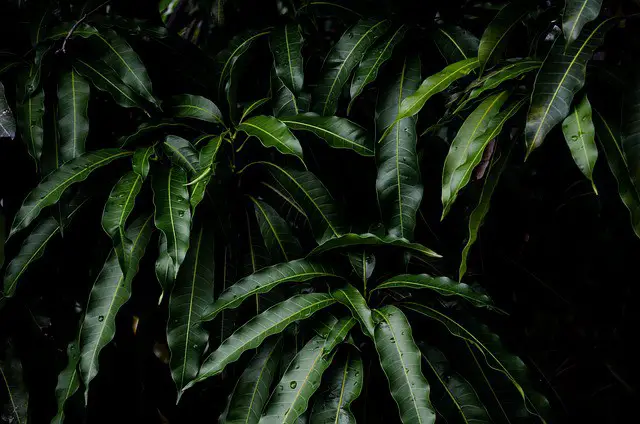
Mango trees are susceptible to various diseases that can cause brown spots on the leaves. These brown spots can be an indication of an underlying problem that needs to be addressed to keep the tree healthy. In this section, we will discuss how to identify brown spots on mango leaves.
1. Visual Signs
Brown spots on mango leaves are usually small, circular or irregular in shape, and can range in color from light brown to dark brown. They can appear on the upper or lower surface of the leaf, and may be accompanied by other symptoms such as yellowing, wilting, or curling of the leaves.
2. Affected Areas
The brown spots can affect different parts of the mango tree leaves, including the tips, edges, and center. In some cases, the spots may be concentrated on one side of the leaf or scattered throughout. The affected leaves may also fall prematurely, which can lead to reduced fruit production.
3. Progression of the Disease
The brown spots on mango leaves can be caused by various diseases, including anthracnose, powdery mildew, and bacterial leaf spot. The progression of the disease can vary depending on the underlying cause.
For instance, anthracnose can cause small, black, sunken spots that grow and eventually lead to blossom blight, leaf spotting, fruit staining, and rot. Powdery mildew, on the other hand, can cause a white, powdery coating on the leaves, flowers, and young fruit.
Bacterial leaf spot can cause water-soaked lesions that turn brown and eventually lead to leaf drop.
It is important to identify the cause of the brown spots on mango leaves to determine the appropriate treatment. Proper care and management practices, such as adequate watering, pruning, and fertilization, can also help prevent the occurrence of these brown spots.
Common Diseases Causing Brown Spots
Mango trees are susceptible to various diseases that can cause brown spots on their leaves. These spots can be caused by fungal, bacterial, or viral infections. In this section, we will discuss some of the most common diseases that cause brown spots on mango leaves.
1. Anthracnose
Anthracnose is a fungal disease caused by the Colletotrichum gloeosporioides fungus. It is the most common disease affecting mango trees. The disease causes small, black or dark-brown spots on the leaves, flowers, and fruits of the tree.
These spots can grow and merge, leading to blossom blight, leaf spotting, fruit staining, and eventual rot. Anthracnose is fostered by rainy conditions and heavy dews. Prevention can be accomplished by maintaining a coating of fungicide on susceptible parts starting when bloom buds begin to expand and ending at harvest.
2. Fungal Infections
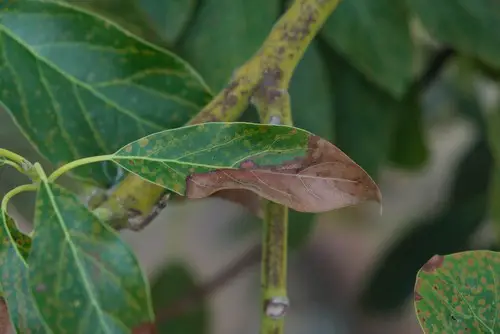
Apart from anthracnose, there are other fungal diseases that can cause brown spots on mango leaves. Powdery mildew is one of the most common fungi that afflicts leaves, flowers, and young fruit.
It appears as a white, powdery coating on the leaves, and can cause yellowing and curling of the leaves. Mango scab is another fungal disease that causes brown spots on the leaves. It is caused by the fungus Elsinoe mangiferae and can cause defoliation of the tree if left untreated.
3. Bacterial Leaf Spot
Bacterial leaf spot is a bacterial disease caused by Xanthomonas campestris. It causes small, water-soaked spots on the leaves, which later turn brown and necrotic. The disease can also cause defoliation of the tree if left untreated.
It is fostered by high humidity and warm temperatures. Prevention can be accomplished by maintaining good hygiene and avoiding overhead irrigation.
Impact on Mango Tree
Mango trees are susceptible to various diseases, which can cause a range of problems including brown spots on the leaves. This section will cover the impact of brown spots on mango trees, including the effects on leaves, fruits, and overall health.
1. Effect on Leaves
Brown spots on mango leaves can be a symptom of various diseases, including anthracnose and verticillium wilt. These diseases can cause defoliation, which can weaken the tree and reduce its ability to produce fruit. Defoliation can also make the tree more susceptible to other diseases and pests.
2. Effect on Fruits
Mango trees with brown spots on their leaves may produce fewer fruits or fruits of lower quality. This is because the tree may not be able to photosynthesize as effectively, which can reduce the amount of energy available for fruit production.
Additionally, defoliation can expose the fruits to direct sunlight, which can cause sunburn and other damage.
3. Effect on Overall Health
Mango trees with brown spots on their leaves may be more vulnerable to other diseases and pests, which can further weaken the tree. This can lead to stunted growth, reduced fruit production, and even death in severe cases.
Additionally, trees with brown spots may be less visually appealing, which can affect their value as ornamental plants.
Prevention and Control Measures
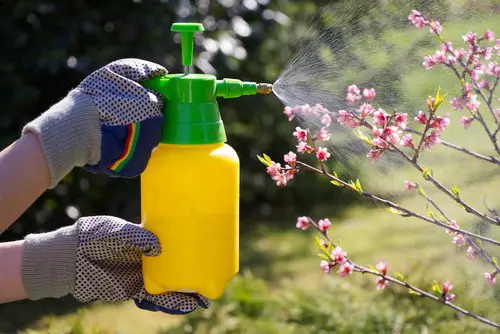
1. Proper Watering
One of the most important things to consider when growing mango trees is proper watering. Overwatering or underwatering can cause stress to the tree, making it more susceptible to diseases and pests.
It is recommended to water the tree deeply but infrequently, about once or twice a week, depending on the weather conditions and the soil type. The soil should be moist but not waterlogged.
2. Pruning
Pruning is another important aspect of mango tree care. Regular pruning helps to maintain the shape and size of the tree, improves air circulation, and removes dead or diseased branches.
It is recommended to prune the tree during the dormant season, which is usually in late winter or early spring. Pruning should be done using clean and sharp tools to prevent the spread of diseases.
3. Use of Fungicides
Fungal diseases are a common problem for mango trees, and they can cause brown spots on the leaves. The use of fungicides can help to prevent and control these diseases. There are several types of fungicides available, including copper-based fungicides, sulfur-based fungicides, and systemic fungicides.
It is important to follow the instructions on the label when using fungicides, and to apply them at the right time and in the right amount.
4. Fertilization
Mango trees require regular fertilization to maintain healthy growth and prevent nutrient deficiencies. Fertilizers should be applied during the growing season, which is usually from spring to fall.
It is recommended to use a balanced fertilizer with a ratio of 10-10-10 or 16-16-16. Overfertilization can cause damage to the tree, so it is important to follow the recommended dosage on the label.
Role of Environmental Factors
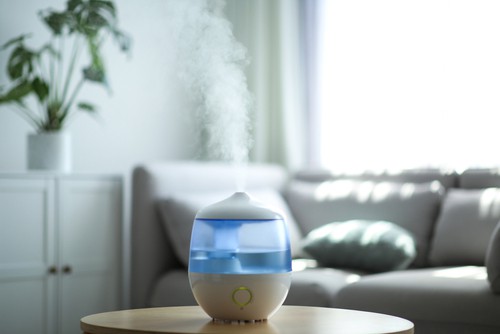
Mango leaves turning brown can be caused by various environmental factors. In this section, we will explore the role of soil conditions, seasonal changes, humidity, and temperature in causing brown spots on mango leaves.
1. Soil Conditions
Soil conditions play a crucial role in the growth and health of mango trees. The pH level, nutrient content, and drainage of the soil can affect the tree’s ability to absorb water and nutrients. If the soil is too acidic or alkaline, it can cause nutrient deficiencies or toxicities, leading to brown spots on the leaves.
2. Seasonal Changes
Seasonal changes can also affect the health of mango trees. During winter, the low temperature can cause stress on the tree, leading to brown spots on the leaves. In addition, the lack of sunlight during winter can reduce the tree’s ability to photosynthesize, leading to nutrient deficiencies and brown spots on the leaves.
3. Humidity
Humidity is another environmental factor that can affect the health of mango trees. High humidity can create a favorable environment for fungal and bacterial growth, leading to brown spots on the leaves. In addition, high humidity can also reduce the tree’s ability to transpire, leading to water stress and nutrient deficiencies.
4. Temperature
High temperature can also cause brown spots on mango leaves. When the temperature is too high, the tree can experience water stress, leading to brown spots on the leaves. In addition, high temperature can also create a favorable environment for pests and diseases, leading to brown spots on the leaves.
Impact on Mango Production
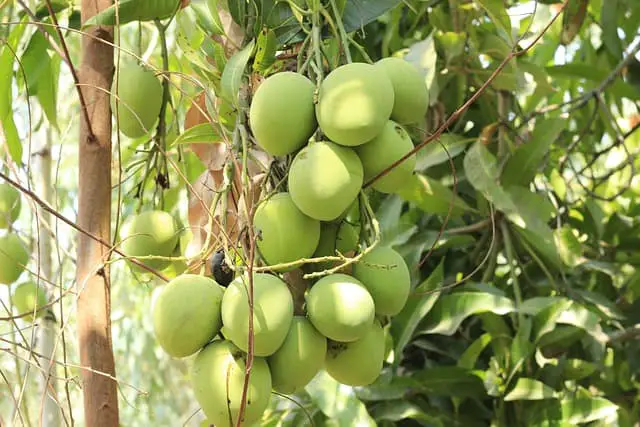
Mango leaves with brown spots can have a significant impact on mango production. The disease anthracnose, which causes brown spots on the leaves, can also lead to fruit staining and fruit rot. This can reduce the quality and yield of mangoes, affecting the profitability of mango production.
Effects on Fruit Quality
Mangoes with anthracnose can have reduced quality due to the fruit staining and fruit rot caused by the disease. Fruit staining occurs when the fungus penetrates the skin of the mango, leaving dark spots on the fruit. This can make the fruit less appealing to buyers and reduce its value in the market.
Fruit rot, on the other hand, can cause the fruit to become soft and mushy, making it unsuitable for consumption.
Effects on Yield
In addition to affecting fruit quality, anthracnose can also reduce the yield of mangoes. Infected trees may produce fewer fruits or smaller fruits, resulting in lower yields. This can be particularly problematic for commercial mango producers, who rely on high yields to maintain profitability.
Preventative measures, such as regular spraying with fungicides, can help reduce the impact of anthracnose on mango production. It is also important to remove infected leaves and fruits from the tree and surrounding area to prevent the disease from spreading.
Home Remedies for Brown Spots
Mango trees are susceptible to brown spots on their leaves, which can weaken the plant and interrupt photosynthesis. While there are fungicides available to treat the issue, some people prefer to use home remedies. Here are a few options to consider:
Using Baking Soda
Baking soda is a common household item that can be used to treat brown spots on mango leaves. To use this remedy, mix a tablespoon of baking soda with a gallon of water and spray the solution on the affected leaves.
The baking soda will help to neutralize the pH of the leaves and prevent the spread of the fungus causing the brown spots.
It is important to note that baking soda can be harmful to some plants, so it is best to test the solution on a small area of the plant before applying it to the entire tree.
Creating a Greenhouse Environment
Another home remedy for brown spots on mango leaves is to create a greenhouse environment. This can be done by placing a clear plastic bag over the affected area of the tree and securing it in place with string or tape.
The plastic bag will trap moisture and create a humid environment that is less conducive to the growth of the fungus causing the brown spots.
It is important to monitor the tree closely while using this method, as excessive moisture can also lead to other issues such as mold or rot.
While home remedies can be effective in treating brown spots on mango leaves, it is important to note that prevention is the best course of action. Proper care and maintenance, including regular pruning and the use of fungicides, can help to prevent brown spots from occurring in the first place.
Frequently Asked Questions

How can I prevent brown spots from appearing on my mango leaves?
To prevent brown spots on mango leaves, it is important to keep the tree healthy and well-maintained. This includes regular watering, proper fertilization, and pruning to remove dead or diseased branches.
Additionally, it is important to avoid over-watering, as this can lead to fungal growth.
What is the best treatment for anthracnose in mango trees?
Anthracnose is a fungal disease that can cause brown or black spots on mango leaves. The best treatment for anthracnose is to apply a fungicide to the affected areas. Copper-based fungicides are often recommended for treating anthracnose in mango trees.
How do I identify and treat rust spots on mango leaves?
Rust spots on mango leaves are caused by a fungal infection. The spots are typically orange or brown in color and may have a powdery appearance. To treat rust spots on mango leaves, it is important to remove any infected leaves and apply a fungicide to the tree.
What are the causes of black spots on mango tree branches?
Black spots on mango tree branches can be caused by a number of factors, including fungal infections, insect infestations, and environmental stress. To determine the cause of black spots on mango tree branches, it is important to inspect the tree for signs of disease or pests.
What fungicide is recommended for treating mango anthracnose?
Copper-based fungicides are often recommended for treating mango anthracnose. These fungicides can be applied to the affected areas of the tree to prevent the spread of the disease.
What are some effective ways to prevent the spread of mango brown spot disease?
To prevent the spread of mango brown spot disease, it is important to maintain good tree health and hygiene. This includes regular pruning to remove dead or diseased branches, proper fertilization, and watering.
Additionally, it is important to avoid over-crowding of trees, as this can lead to the spread of disease.

Hey, I’m Lisa and I’ve been an avid gardener for over 30 years. I love writing, talking and living in the garden! Feel free to connect with me on my socials below


